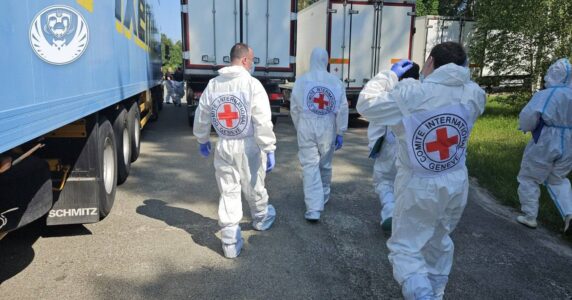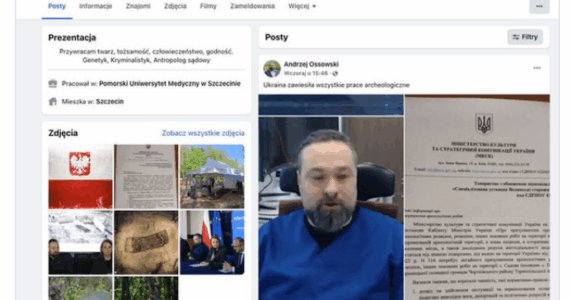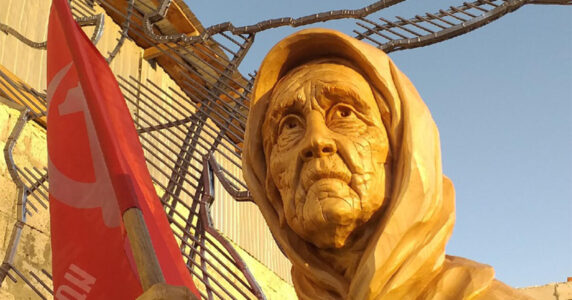Navigation and useful materials
The Kremlin is boasting of “liberating the LPR,” but treats the main hero of this “victory” in a rather shady way. The Centre for Strategic Communication and Information Security has collected the main fakes and narratives of the Russian propaganda of July 4.
- “The second-best army of the world” advanced by 117 km in 131 days
- What about the encirclement?
- Awaiting the zero-turnout “referendum”
- Russian Minister of Defence put in his place
The second-best army of the world” advanced by 117 km in 131 days
Russian Defence Minister Shoigu announced the complete “liberation of the Luhansk People’s Republic” at a meeting with Putin. The latter thanked for the “victory,” awarded two commanders of occupier troops with the Hero of Russia title, and ordered the units of the “Centre” group who participated in hostilities in that area to get some rest.
“Other military units, including the ‘East’ and ‘West’ groups, must complete their tasks as planned,” said Putin. All this happened on July 4. “The special operation for the liberation of the Donbas,” as you are well aware, started on February 24.
IN REALITY, the distance between Luhansk and Lysychansk is almost 117 kilometres. It takes an hour and 56 minutes to drive between the two. It took the Russian army 131 days to cover this distance. The only more or less formalized military “victory” (of course, temporary) in the war with Ukraine cost Putin more than 36,200 soldiers, 1,589 tanks, 3,754 armoured fighting vehicles, 804 units of artillery systems, 246 anti-aircraft guns, 105 air defence systems, 217 aircraft, 187 helicopters and some other “trinkets,” like the Moskva warship.
That’s all you need to know about the “invincible and legendary second-best army of the world” in Ukraine. Everything else is propaganda, like “we are saving the civilians of Luhansk oblast,” or fakes, like the “Azot plant in Sievierodonetsk rigged with explosives by Nazis.”
It will forever be recorded in the history of this war that “reaching the administrative borders of the LPR,” which were 117 kilometres away from Luhansk, took the Russian army 131 days. And that’s it.
What about the encirclement?
Back in May, Russian military experts started to hype up the inevitable encirclement between Sievierodonetsk and Lysychansk. They wrote that “according to various data, 9 to 11 thousand Ukrainian servicemen from various units are actually besieged in Lysychansk and Sievierodonetsk.”
They also pretend-analysed Ukrainian social media and concluded that the Ukrainian leadership do not have a single opinion concerning its troops, who may end up in encirclement. Eventually, Moscow went so far as to claim that the decision to withdraw combat-ready units and officers was “a compromise between President Zelenskyy and Commander-in-Chief of the Armed Forces Valerii Zaluzhnyi.”
The western “icing” on the propaganda cake was the idea that the Sievierodonetsk encirclement allegedly makes Europe less decisive.
IN REALITY, there was no encirclement. For starters, no Russian media published any footage of captive Ukrainian soldiers. Not even staged pictures.
The Ukrainian defence forces moved in an organized manner to previously established positions: Siversk, Soledar, Bakhmut. From a military standpoint, it made no more sense to keep holding Lysychansk. And even less sense to hold on to Sievierodonetsk. The city is barely there. It suffered the same fate as the previously “liberated” Mariupol.
Here’s what we have got:
- The occupiers’ forces are limited in actions and have suffered major losses;
- Much-needed time has been gained for further supply of Western weapons and improving the second line of defence;
- Groundwork has been laid for advancing on other areas of the front;
- The Ukrainian military and political command did not follow the Stalinist principle of “not a single step back”;
- Kyiv follows very simple logic: when there is an army, territory will be recovered. Without an army, there will be no way to recover any territories.
Russian propagandists and so-called military experts should probably be blocked themselves. In terms of information.
Awaiting the zero-turnout “referendum”
The leader of the so-called “LPR” Pasichnyk has already claimed that “experienced, qualified people will be appointed to leadership positions in Lysychansk; it is possible that they will be representatives of the former administration.”
It seems that the fake republic will soon start talking about a future referendum about joining something — who knows what, at this point, since the Kremlin has not decided on its strategy, either. If Shoigu’s army continues its glorious march of 117 km in 131 days, it is unclear where this will all lead. In Kherson, they already announced a “referendum” on September 11. Well, we’ll see. “South Ossetia,” which has been “independent” since 2008, can share some experience here.
IN REALITY, the occupiers are facing another major problem on the “liberated” territories — “legitimizing” the “referendum itch” of the local collaborators.
The motivation of the latter is obvious: to formalize at least some kind of status with a referendum to “make it official.” And later, they can give up the made-up positions and get lost in the endless space of Russian bureaucracy. One example is Trapeznykov, one of the former “DPR” leaders, who is now governing the Russian Kalmykia.
There are, of course, other examples, way less successful. But the current Luhansk wannabes believe it’s their lucky day.
But what should Putin do? Of course, Putin can hardly be called a strategic thinker, but how about at least a tactical task — finding people who would show up to the “referendum”? Strangely, as of 2017, there were 100,000 residents in Lysychansk, according to Surkov’s calculations, “waiting to be liberated from Kyiv Nazis.” And now, when the time has come, they are just 10,000 max. Somehow, nine out of ten Lysychansk residents did not wait for the “liberators.”
Of course, they will write whatever numbers of supporters they like. But how will they come up with the 100,000 residents of Lysychansk, the same number for Sievierodonetsk, almost 57,000 people from Rubizhne and other, smaller cities and towns of the “liberated” Luhansk oblast?
First, this is some tough logistics.
Second, if Moscow decides to use its favourite electoral trick in the form of electronic vote, world hackers will have their work cut out for them.
And there is a third way, a “parliamentary” vote, but considering various dangers that regularly befall newly found “elected officials,” there is no guarantee here.
Of course, Moscow will come up with something. Putin has probably come to terms with the fact that nobody will recognize this (other than maybe Syria). Although he stubbornly believes that he will handle it all with the West later.
Russian Minister of Defence put in his place
Let’s wrap up with the meeting of Putin and Shoigu, where the latter reported to the former that “LPR is ours.” Interestingly, the published footage shows that the dictator tells his defence minister that he has already received reports from two commanders of the “Ukrainian vectors” Lapin and Surovikin.
IN REALITY, this way, Putin clearly showed Shoigu his place in the new hierarchy. Before listening to his chief military commander, Putin first listened to direct reports from his subordinates.
What was it: a protocol faux-pas, or an understated show of distrust?
What’s interesting, Putin’s spokesman Peskov said just a few days ago that the Kremlin maintains all anti-COVID measures.
These measures can be found in detail in the study “Kremlin Quarantine during the War. How Vladimir Putin’s Health Is Guarded in Russia.” It was released by the BBC. For instance, the “Rossiya” summer squadron, whose crews fly with Putin, spent 125 million roubles on COVID tests. Starting in June 2021, pilots and flight attendants have had to take up to two thousand PCR tests and up to 600 antibody tests every month. In addition, about 50 blood tests for biomarkers, and about 100–200 stool tests to identify the coronavirus.
94-year-old veteran Akhat Yulashev from Kazan was kept in quarantine for two weeks before being allowed to shake Putin’s hand at the most recent parade on May 9. This was the case for everyone sitting next to Putin. This shows that the Kremlin chief is maniacally obsessed with his health.
Considering the last meeting between Putin and Shoigu, this becomes interesting because on June 26, the latter allegedly inspected the command posts of the Russian military in Ukraine.
Only a week passed since then and before the meeting. So, either the quarantine before meeting Putin has become shorter, or Shoigu did not inspect the posts on June 26, or it was not Shoigu who did it, or his meeting with Putin was completely staged.
In any case, the Russian minister of defence, who happily reported about the “liberation of the LPR,” was put in his place. It no longer matters if it was done by Putin or the Russian television. And that’s all you need to know about July 4, the 131st day of Russia’s war in Ukraine and the “liberation of the LPR.”
If you have found a spelling error, please, notify us by selecting that text and pressing Ctrl+Enter.


